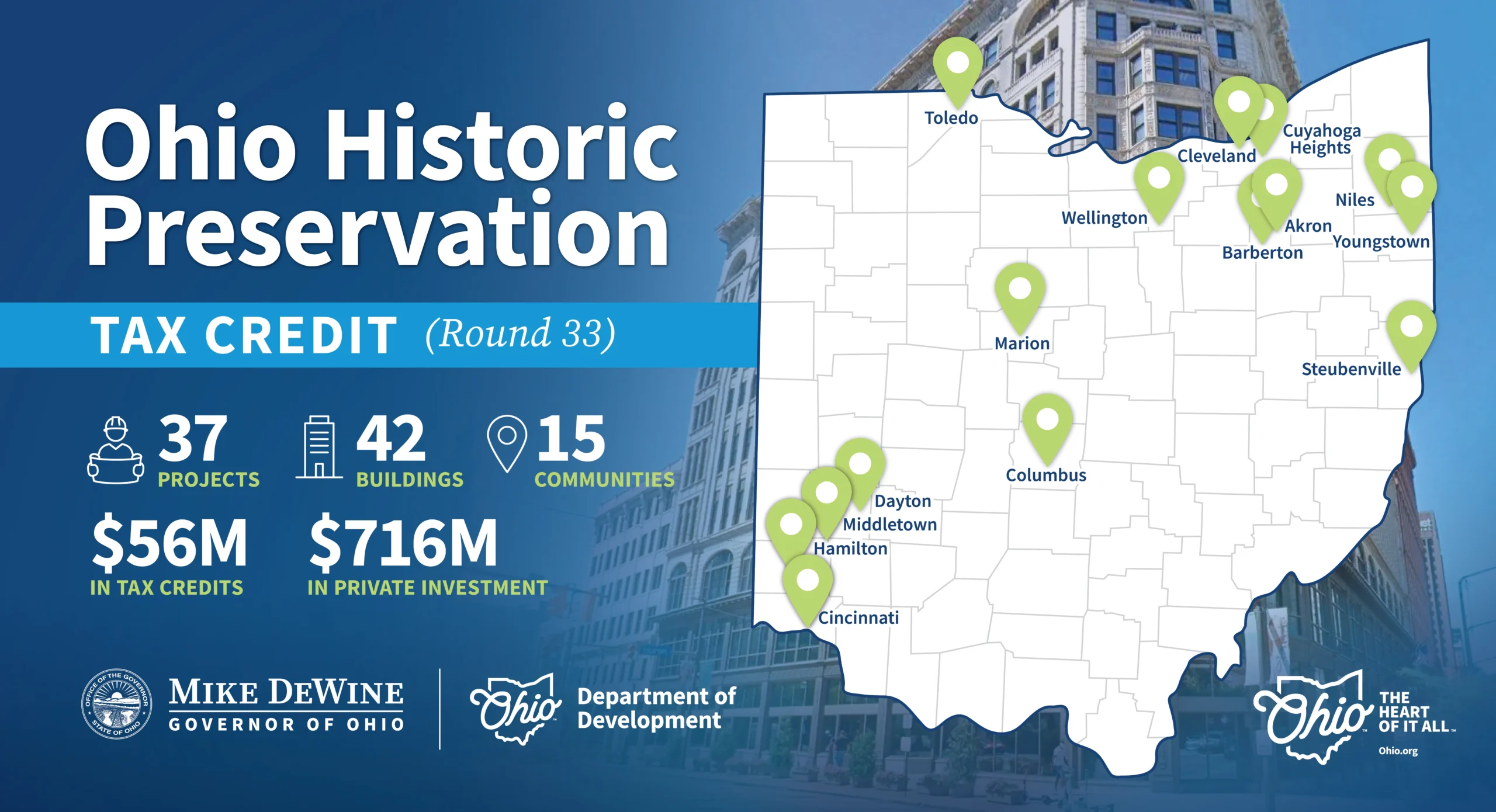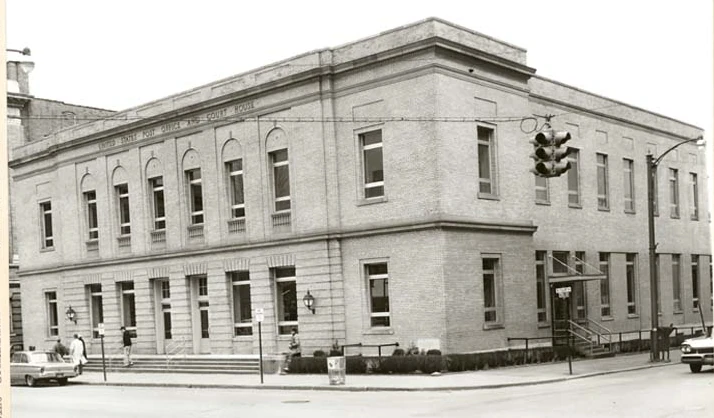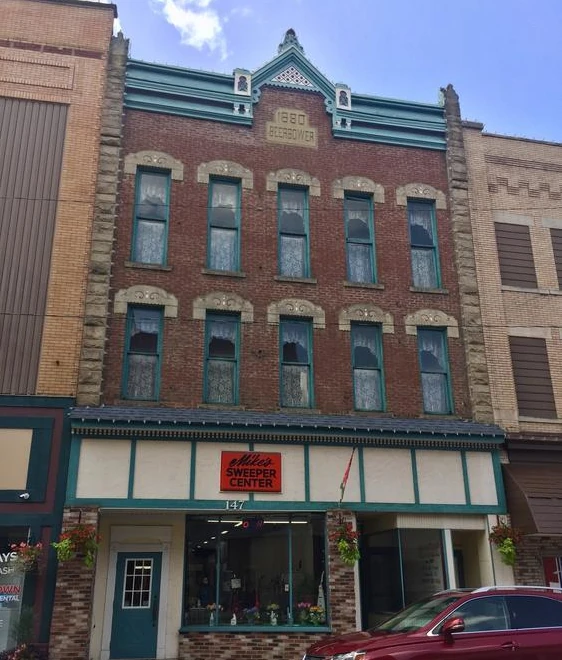Historic Tax Credit Program Benefits 37 Ohio Projects

Editor’s Note: At December 16 Barnesville Village Council meeting Rose Grear and Attorney Aaron Bruggeman of the Barnesville State Theater Company mentioned the theater project is an ideal candidate for the Ohio Historic Preservation Tax Credit Program. Also eligible could be the Barnesville Depot and other historic buildings in the downtown historic district. The same week, Ohio Governor Mike DeWine announced the most recent grant round for the program that includes two Steubenville projects.
(COLUMBUS, Ohio)— Ohio Governor Mike DeWine, Lt. Governor Jon Husted, and Ohio Department of Development Director Lydia Mihalik recently announced more than $56 million in tax credits to support the rehabilitation of historic buildings across the state.
The credits were awarded as part of the Ohio Historic Preservation Tax Credit Program, which provides financial incentives for the private redevelopment of Ohio’s historic buildings.
“By preserving our historic buildings, we’re retaining the unique identity of Ohio’s communities,” said Governor DeWine. “Through the tax credit program, we’re ensuring that future generations can experience the character and stories that shaped our state in the spaces where they happened.”
In total, 37 projects will be awarded $56,125,248 in tax credits to preserve 42 buildings across the state. The projects are expected to leverage approximately $715 million in private investments.
“Historic preservation is an economic driver in Ohio communities – it’s more than just saving old buildings,” said Lt. Governor Husted. “We’re preserving Ohio’s history while investing in its future through this program.”
Among the 15 communities receiving tax credits are Akron, Barberton, Cincinnati, Cleveland, Columbus, Cuyahoga Heights, Dayton, Hamilton, Marion, Middletown, Niles, Steubenville, Toledo, Wellington, and Youngstown.
Locally, State Senator Brian Chavez (R-Marietta) provided more details on the two Steubenville projects included in the grant round funding.
Ohio State Senator Brian Chavez has announced more than $330,000 in tax credits to rehabilitate two historic Steubenville buildings.
Those include the U.S. Post Office and Courthouse and the Beerbower building formally known as the Mike Sweeper Center. Both are located on North Fourth Street.

Steubenville Post Office and Federal Courthouse c. 1966
“It is important that we invest in historic spaces across our state,” Chavez told WTOV News. “Updating these spaces for the needs of our community now and in the future is an excellent way for history to be preserved.”
Purchased by the College of St. Joseph the Worker in August, the U.S. Post Office and Courthouse will receive a $245,000 tax credit to transform the second floor of the building into a library, classrooms, and office space.
The first floor is still home to Tri-State Security and World Radio Telecommunications, which was purchased from the Hindman Family.
As for the second-floor renovations, College of St. Joesph the Worker Provost Jacob Imam said they hope to transform the space into something as strong as the building’s history.
“To highlight the beautiful craftsmanship that our Steubenville ancestors achieved here,” Imam said. “We have floor to ceiling wall paneling tire oak, which really you don’t see any more inside, and we want to open this up and make this available, not only to our facility, staff and students, but also to the town itself.”
Students from the college will help with renovations, which will take place over the next year. Tax credit money will be issued once construction is complete.

Beerbower Building, Downtown Photo Tour in 2018
As for the Beerbower Building, it will receive an $87,500 tax credit to turn the building into a mixed-use property with commercial and residential space. The building was purchased by real estate holding company HCS of Merchants Isle LLC.
It plans to have commercial space on the first floor, with residential spaces on the second and third floor.
Statewide, the tax credits will assist in preserving historic buildings which are often vacant and generate little economic activity. The buildings will be rehabilitated into residential housing, commercial and office space, and manufacturing facilities. Once rehabilitated, they will drive further investment and interest in adjacent property. Developers are only issued the tax credit once project construction is complete and all program requirements are verified.
“Communities thrive where they honor their roots,” said Lydia Mihalik, director of the Department of Development. “The awards we are making through the Ohio Historic Preservation Tax Credit Program are helping communities in their efforts to connect their past with opportunities of the future.”
The Historic Preservation Tax Credit program is administered in partnership with the Ohio History Connection’s State Historic Preservation Office. The State Historic Preservation Office determines if a property qualifies as a historic building and that the rehabilitation plans comply with the United States Secretary of the Interior’s Standards for Rehabilitation.
“Rehabilitation of historic buildings through the historic program and federal historic tax-credit programs revitalizes main streets, helps the environment by reusing a structure that is already built and creates jobs – with the added bonus of preserving local history,” said Mariangela Pfister, Department Head and Deputy State Historic Preservation Officer for Technical Preservation Services in the Ohio History Connection’s State Historic Preservation Office.
The Ohio Department of Development empowers communities to succeed by investing in Ohio’s people, places, and businesses. Learn more about our work at development.ohio.gov.
The Ohio History Connection is a statewide history organization with the mission to spark discovery of Ohio’s stories. As a 501(c)(3) nonprofit organization chartered in 1885, the Ohio History Connection carries out history services for Ohio and its citizens focused on preserving and sharing the state’s history. This includes housing the State Historic Preservation Office and the official state archives and managing more than 50 sites and museums across Ohio. For more information, go to ohiohistory.org. The Greater Columbus Arts Council and the Columbus Foundation provide support for Ohio History Connection programs.
Barnesville Area News Needs Your Support!
We're dedicated to providing coverage of the local happenings in Barnesville and the neighboring communities.
As a non-profit entity, we rely on the donations of readers like you.
Make a donation today and you'll be helping keep local news alive in the Barnesville area.

